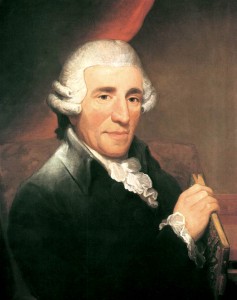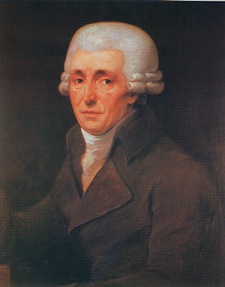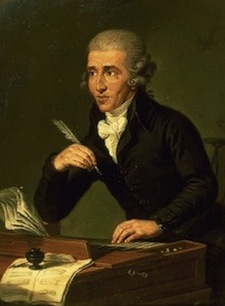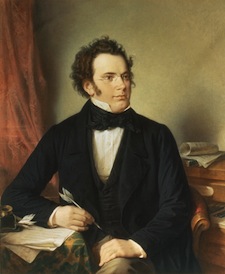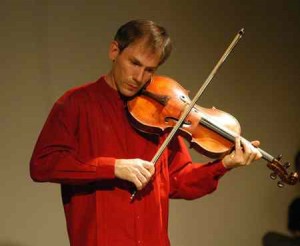I thought I’d be able to finish the string quartet discs tonight. I was wrong. There are just so many of them…
Posts Tagged ‘Franz Joseph Haydn’
Day 95. Haydn.
Saturday, May 22nd, 2010Day 93. Haydn and Duke Ellington.
Thursday, May 20th, 2010I’m continuing work on the stack of Haydn string quartets tonight (only got through a few last night) as well as a few Duke Ellington discs. The Haydn discs, by the way, are from the Naxos set recorded by the Kodaly Quartet. As with most things Haydn, I tend not to think about listening to something by him until I do, and once I do I am almost always struck by how good his music is. And I wonder why he doesn’t get the same amount of attention as Mozart or Beethoven. While he is often given credit as the inventor (or standardizer) of classical form and style, the virtuosic lyricism of Mozart and the dramatic pre-romanticism of Beethoven is the music that is used to complete the music history story of the classical period. Part of it, I am sure, is because it wraps up into a neater package that way. Haydn had these ideas, and Mozart, Beethoven (and Schubert, etc. etc.) expanded them, then etc. etc… But I imagine another big part is the sheer volume of work. I can literally spend two days listening to all of his symphonies without repeating a single one. The five hours it takes to listen to all the Beethoven symphonies lends itself much more to repeated listening of the whole body of work. So of course I know it much better. But with Haydn, even if I chose the top 20 and got to know them as well as I know the Beethoven 9, I would still have 4/5 of his symphonies to be surprised by! So, for now I think I will let myself enjoy the surprises when I get to them. And I will also let myself remember that if I am looking for some good music that I haven’t heard yet, I can dig into my Haydn collection and probably be pleased.
The Duke Ellington tonight is a nice cross-section of his work. There is a collection drawn from a PBS documentary about him that covers a VERY wide range of his work. Basically, it is like taking a survey course on Duke Ellington. With that disc, you get an excellent sense of who Ellington was as a songwriter / composer. Then there is the mostly amazing ‘Ellington at Newport’ from 1956 which shows Ellington the band leader, and finally ‘Money Jungle’, a trio disc from ’62 with Max Roach and Charles Mingus which shows us Ellington the phenomenal pianist.
‘Money Jungle’ is every bit as amazing as you would expect an album by Ellington, Roach and Mingus to be. The playing, all around, is superb. And in the smaller setting, you hear Ellington’s playing in sparser surroundings. This also means that you hear him filling in more space with his playing, and at times his left hand sounds like McCoy Tyner is sitting in. At times, his playing is HEAVY. And I have heard him voice certain chords like this in other contexts (most notably, in the Ella Fitzgerald ‘Ellington Songbook’ recordings), but in a smaller setting with less players, it sounds like he is giving Mingus a run for his money at times. It sounds like he is giving Max Roach a run for his money… and on top of that, he is giving his right hand a run for its money. The playing is just amazing.
But it is the playing of Paul Gonsalves on the Newport disc that is the standout. After a rough start to the festival, the band sounds a bit warn out at times in the first half or so. But by the time Gonsalves starts his solo during ‘Diminuendo and Crescendo in Blue’ you think something amazing has to start happening sometime soon. And it does. The 27 chorus solo that follows is one of the most amazing 6 minutes or so ever captured live on tape. And not to diminish the amazing playing of Gonsalves, but it is also what is going on around him that adds to the moment. Duke egging him on to keep going early in the solo break. Duke and the rest of the band pushing him even further. Then the crowd gets into it. You can literall feel the excitement rise with this recording, and then it ends. Literally, it sounds like Gonsalves has possibly collapsed and is out of breath. It is one of the least graceful endings to a solo you will ever hear, but it is perfect. Gonsalves has given it everything he has got, and when the tune ends, the roar from the crowd (and the time it takes Duke to calm everyone back down to get the concert moving again) shows how just about everyone there realizes how luck they were to hear what they just heard. I’m lucky to hear it. The history of music is lucky that it was caught on tape. I still get chills when I hear this track.
Day 51. Haydn. LOTS of Haydn. And Schubert.
Saturday, March 13th, 2010It has been a tumultuous couple of days on one hand, simply busy on the other. Last night was simply hectic, and today we had my parents over for their anniversary. Ripping CDs has been a low priority as a result, so I transferred more purchases (mp3 downloads) from the past year or so from my main laptop onto the server computer. After ripping all the Mozart symphonies the other day (and already having all the Beethoven symphonies on that computer) I decided today was a good day to round out the Classical periods heavy hitting symphonists. So the 45-CD Antal Dorati complete Haydn symphonies and the Goodman / Hanover Band Schubert symphonies are on deck for tonight.
I don’t know why, but I am always so surprised how much I like Haydn when I listen to him. And the Dorati recordings are lots of fun. First of all, they are complete and this is no small task. 104 numbered symphonies, a few lettered ones and all sorts of works that basically are symphonies (just not in name). It is one thing to have 104 orchestral works under your wing (as Dorati does here) but this of course was not all Dorati did. During the 50s and 60s, his Mercury Living Presence recordings (especially the Bartok recordings) are just fabulous. He recorded an amazing amount of music well. And to take on a project the size of the Haydn symphonies is nothing short of impressive.
Papa Haydn’s most significant achievement, in my opinion, was his formalizing of the structures and forms that would occupy most of the Viennese Classical period. And the symphonies are a large part of that (though in the String Quartets you can see these ideas grow and solidify). He had what any composer today would call a pretty cool gig… writing music for a prince with a house orchestra. The prince also played Baryton (a COOL instrument) so he also wrote a huge body of work for that instrument. His music had rhetoric, from the contrasting ideas that exhibit tension then harmony in the sonata-allegro form to the ‘Farewell’ symphony that he wrote to tell the prince that the musicians needed a vacation. But what surprised me most about Haydn when I listen to him is that you really can hear how his approach to motive and development would find its greatest continuation in the music of Beethoven. Haydn wrote 104 symphonies, and as Beethoven’s career closes out the Classical period he finishes 9 that really define and develop the form into the Romantic tradition.
Schubert is the other side of this coin in my mind. He picks up where Mozart left off and does a similar kind of expansion of form with the similar kinds of melodic gifts that Mozart had. The Goodman recordings are on period instruments and use an orchestra appropriate to Schubert’s time. Like Beethoven, Schubert’s work tends to be overly romanticized as well and the Goodman recordings do a great job placing Schubert within the Classical tradition. The recordings have a lightness to them at times, and more detail comes out from the winds (having a smaller proportion to the strings then most modern orchestras). The ‘Unfinished’ benefits particularly well. The second movement is light and airy at times, dramatic at others. These contrasts are shaped even better when the period instruments are used.
With the Haydn, Mozart, Beethoven and Schubert discs all on the computer now there are over 75 discs of classical symphonies. As the rest of the discs of this repertoire are eventually ripped (multiple Beethoven recordings, another Schubert set as well as quite a few individual recordings of Haydn and Mozart symphonies) I think there will be over 100 discs represented. Until tonight, I don’t think I realized what a huge proportion of my recordings represented the Classical Symphony.
Day 40. Garth Knox, Haydn and Marais.
Monday, March 1st, 2010Most of tonight’s choices come as a result of talking to an old friend from Berkeley. We were discussing early music in particular and some of the ‘obsolete’ instruments that would be nice if they weren’t so obsolete. Viola da Gamba was one of the them (which I played for a few years at UW during grad school, and would love to get back into again) as well as the Baryton and Viola d’Amore. These last two are string instruments (similar to cello and viola, respectively) that feature a second set of strings that are strung through the neck and below the regular strings. These are usually tuned to a specific scale and are then allowed to resonate in sympathy with whatever is being played – creating a stringy, halo-ish reverb. Haydn wrote a huge number of pieces for Baryton trio (that have been recorded a couple times). But just as rare is the Viola d’Amore (though, since I have helped out Garth Knox with a few concerts I have actually seen and heard this instrument a number of times).
Garth has been touring and gathering new works for Viola d’Amore for a number of years now, and I have also worked with him on a project to re-do the electronics for Grisey’s ‘Prelude’ for viola and resonators. Sympathetic vibration (and spectral modeling) has been a fascination of mine for a number of years now, going back to my ‘Music for Bassoon’ that has a VERY crude model of a resonating piano as its basis. But since that piece (over the past 6 years or so) I have been working on different ways to make it sound as though one instrument is playing through another. Working on the Grisey piece actually brought me close to doing what I wanted, but it wasn’t until I was working on the electronics for my viola piece ‘Theta‘ where I was able to get something to work that would take a snapshot from a performer in real-time and then let that player make it resonate. Hearing Garth play pieces on the Viola d’Amore was really the inspiration for this, and I spent a better part of a year coming up with algorithms that allowed me to do this, and I think the sonic result is quite convincing.
However – I’m not saying that I think my stuff sounds like Viola d’Amore. The sound of this instrument is beautiful and his playing on his disc ‘D’Amore’ is wonderful. There are some older pieces on the disc (a Marais piece, some traditional tunes as well as a set of variations by Garth Knox on ‘Malor Me Bat’), but there are also a couple of modern pieces that take advantage of the idiosyncrasies of the instrument. Of particular note is Klaus Huber’s ‘…Plainte…’ which is an elegy to another favorite composer of mine Luigi Nono. The microtones slide around leaving halos behind them when they come into tune with the sympathetic strings in a delicate way.
I also ripped Garth’s ‘Spectral Viola’ disc (with Grisey, Murail, Scelsi and Radulescu) and his solo debut disc on naïve (with the Berio Sequenza for solo viola and Sciarrino’s ‘Tre notturno brillante’). The Sciarrino may be one of my favorite late 20th century pieces… and I am not ashamed to say that I grabbed a number of tricks from the score for these works for ‘Theta’.


